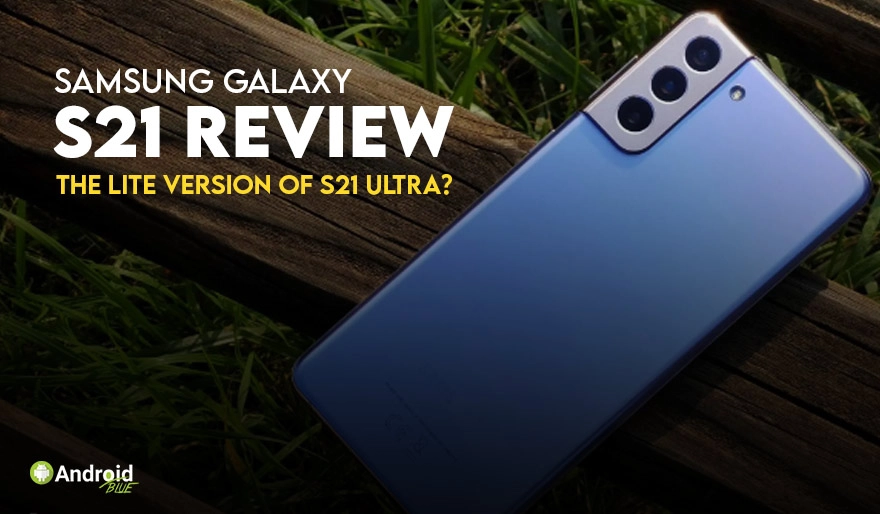Samsung Galaxy S21 Review: The Lite Version of S21 Ultra?
26 min read Samsung Galaxy S21 is available in the market now. I know the title is confusing, but I will explain why I have made such a statement about this phone. To provide smartphones with premium specs and at... August 01, 2023 07:42
Samsung Galaxy S21 is available in the market now. I know the title is confusing, but I will explain why I have made such a statement about this phone. To provide smartphones with premium specs and at the same time at a lower price tag, price-cutting from essential sections of a premium-grade smartphone is common for every smartphone brand. And Samsung is one of them as well.
Let me explain what’s the catch here!
You probably know, Samsung Galaxy S21 Ultra is being sold with 1072$ price tag on Amazon. On the other hand, Galaxy S21 5G price is 699$ on the same marketplace. If you just avoid the phone size, considering the specs and all other aspects, they are almost identical. Then the question appears, what’s the reason behind the significant price gap?
Here comes the tricky part! If you inspect all the details of these through the magnifying glass, something interesting will surely come out! Let’s do that together.
When Samsung Galaxy S21 is Going to be Released?
Samsung Galaxy S21 comes with two different processors. The Snapdragon variant is available only for the USA. And the Exynos version is available for the rest of the world.
According to some reliable resources, Samsung Galaxy S21 was globally launched on 29th January 2021. So there is no waiting period for that. Both the variants are available in the current market.
What’s in The Box?
Nowadays, smartphone manufactures are in competition to reduce the box size. Apple first initiated the trend, and then other brands are following the same steps. And it’s an open secrete that Samsung is not beyond the track as well.
Unboxing Samsung Galaxy S21 will give you the same vibe. What you are getting inside the box-
- The Galaxy S21 itself
- SIM card ejector
- USB-C to USB-C cable
- Some papers that you will never read!
Here is the catch! There is no charging adapter included in the box. The charging adapter comes separately in the market, where you have to spend some bucks to have it. The phone supports wireless charging as well. In that case, my recommendation will be to grab the wireless charger instead of the wired charger.
First Impression - Design and Look
Considering this phone’s predecessors’ design language, Samsung Galaxy S21 has made a smart improvement in the design language. Yes, the phone doesn’t come with the glass back panel in the rear area. But it doesn’t feel that cheap when you will grab it with your hand. You will barely notice that you are holding a phone that’s rear is not glass finished.
In the front section, you are getting Gorilla Glass Victus as your display guard. The middle frame is made with aluminum. Therefore, this phone’s whole structure is a stacked combination of glass, aluminum, and polycarbonate plastic with an ultra-premium finish.
Now I should mention some key points of this phone where you will get the overall idea of its design, one hand usability, and some other aspects.
Curved Design
In the overall design language, you will feel Galaxy S21 is kind of curvy shaped when you will pick it up with your hand. And this move was intentional from Samsung to allow you to grab your phone with the highest convenience.
Rectangular-Shaped Camera Housing
Samsung put the triple camera setup with the rectangular-shaped camera housing. There is a noticeable camera bump but it will not harm your day-to-day usage. The bump area is made with metal, where the rest of the back panel is plastic made.
The Punch Hole Front Camera
There is no other better way to put a front-facing camera without cutting any portion of the display panel. The punch hole technology is the most accepted and less inconvenient way to place the front-facing camera. Samsung did the same thing to place the front camera with a tiny-sized punch hole.
The Physical Overview
Before purchasing Galaxy S21, you should know the physical overview of this phone first. After all, the phone size, camera bump, and the position of your phone’s other vital segments can influence your overall convenience of using a phone.
Let’s have a look-
Dimension: 151.7 x 71.2 x 7.9 mm
Volume Rocker and Power Button: Side Mounted
Loud Speaker: Bottom Firing (With stereo support)
3.5mm Audio Jack Port: No
Rear Camera Housing: Top-left corner in the back panel
Front Camera Position: Punch hole camera at the top middle position
Galaxy S21 comes in four different colors from which you can pick your one considering your choice. The name of all the colors are -
- Phantom Gray
- Phantom White
- Phantom Pink
- Phantom Violet
Galaxy S21 Full Specification
Before deep-diving into the more deep discussion, let’s know in detail what Galaxy S21 is offering in pen and paper. That will help us initially figure out how much performance we can expect from this particular phone. Here is the detailed representation of Samsung Galaxy S21 specs.
General Overview | |
Brand | Samsung |
Model | S21 |
Release Date | 29th January 2021 |
Body Type | Glass, Plastic, and Aluminium finished |
Weight | 169g (Approximate) |
Display | |
Screen Size | 6.2 inch |
Aspect Ratio | 20:9 |
Resolution | 1080 x 2400 pixels |
Brightness | 1300 nits (Peak) |
Pixels per Inch | 421 |
Protection | Gorilla Glass Victus |
Touchscreen | Yes |
Hardware | |
Processor | SOC: Exynos 2100 (5 nm) - (International) Qualcomm SM8350 Snapdragon 888 (5 nm) - (USA/China) |
Clock Speed: Exynos 2100- 2.2GHz | |
Total Core: Octa-core (For both Exynos and Snapdragon) | |
Architecture: 5nm (For both Exynos and Snapdragon) | |
CPU Bit: 64 Bit | |
Ram | 8GB |
Rom | 128/256 GB (UFS 3.1) (Not extendable) |
GPU | For International Version: Mali-G78 MP14 For USA/China Version: Adreno 660 |
Camera | |
Back Camera |
Secondary - 12 MP, f/2.2, 13mm, 120˚ (ultrawide), 1/2.55" 1.4µm, Super Steady video Telephoto - 64 MP, f/2.0, 29mm (telephoto), 1/1.72", PDAF, 0.8µm, OIS, 1.1x optical zoom, 3x hybrid zoom |
Front Camera | 10 MP, f/2.2, 26mm (wide), 1/3.24", 1.22µm, Dual Pixel PDAF |
Sensors | |
Fingerprint | Under display (Ultrasonic) |
Accelerometer | Yes |
Gyroscope | Yes |
Compass | Yes |
Proximity | Yes |
Barometer | Yes |
Connectivity | |
Dual SIM | Yes |
WLAN | Wi-Fi 802.11, Wi-Fi Direct, Hotspot |
Bluetooth | 5.0, A2DP, LE |
GPS | Yes, with A-GPS, BDS, GALILEO, GLONASS |
NFC | Yes |
Infrared (IR Bluster) | No |
USB | USB Type-C 3.2 |
Platform | |
OS (Operating System) | Android 11, One UI 3.1 |
Power Backup | |
Battery Capacity | Li-Ion 4000mah, non-removable |
Charing Type | 25W fast charging support |
Wireless Charging | Yes, 15W |
Reverse Wireless Charging | Yes, 4.5W |
Price | Around 699$ |
How Does Samsung Galaxy S21 Perform in Real Life?
Now you have the full specs in your hand. But the question is -
Can it perform in real life as we can assume considering the overall spec?
Well! Only assuming is not the appropriate way to get the actual result. We need a real-life experiment in this run. Let’s talk about the real-life performance of Galaxy S21 in detail.
Camera Performance
S21 comes with a triple camera setup in the rear panel with the rectangular-shaped metallic camera housing. In the front panel, you are getting a 10MP selfie camera with a punch hole cut out.
I will show you the performance of each of these lenses separately and give you a sample image taken with these to get an approximate idea about the capability of these lenses. The photos will be the visual representation of a side-by-side comparison between Galaxy S21 and Galaxy S21 Ultra.
After this, you will easily get an idea about how many quality photos the rear camera setup combined can capture for you in different tweaking.
Primary Shooter
The primary camera of S21 is 12MP which is a wide-angle lens. The 1.8µm aperture allows the lens to grab enough light when you take photos with the shooter. It eventually helps to capture quality photos in low-light conditions. This shooter will help you to record decent quality videos as well. The OIS (Optical Image Stabilization) will allow you to get the most stable video footage by ignoring your shaking hand.
Secondary Shooter
Samsung introduced the 12MP Ultra Wide Angle camera as the secondary shooter of S21, allowing you to capture pictures and videos at 120˚ ultra-wide angle. This lens comes with the Super Steady Video feature with auto-HDR. Combining all of these allows the lens to capture more vibrant and almost noiseless images in daylight and night condition.
Telephoto Lens
The 64MP Telephoto lens of S21 has brought a different dimension in the camera setup of this phone. The lens comes with an f/2.0 aperture. The OIS (Optical Image Stabilization) is present here as well, to allow you to experience more stable footage while recording videos. The 1.1x optical zoom hold the potential to capture zoomed photos and videos without sacrificing the quality and details.
This lens supports up to 3x Hybrid Zoom. The software-based zoom works up to 30x. But as per my research on the camera section, it will be a good practice if you zoom not more than 10x if you don’t want to lose a significant amount of details from your picture.
Selfie Camera
You are getting a 10MP lens with f/2.2 aperture and Dual-Pixel PDAF feature in the selfie camera punch-hole cut out. In the last few years, Samsung brought some significant tweaking in the camera section that improved the camera quality and the overall customization opportunity as well. You can shoot your videos in 4K resolution with 60FPS, which is surprising. The dual video feature can be proven helpful for you, especially when you are a vlogger.
In the real-life performance, the quality of selfie footage was decent. Considering the price, the details were rich enough in the images. In low light conditions, the Android Blue team found no focus hunting issue during testing the unit. Edge detection was also accurate in portrait mode.
Overall, S21 holds a decent selfie camera so far.
The Hardware Discussion
You have known already, Samsung Galaxy S21 comes with two different variants considering the types of processors.
- Snapdragon 888
- Exynos 2100
If you live in the USA region, then you can get the Snapdragon 888 variant. And there are plenty of phones around the globe right now that are using the same processor. Most of these are 8GB Ram Smartphones, whose performance is known to almost all techy people.
Gaming Performance
If you are an international user, then you will get the Exynos 2100 variant from the market. And my rest of the discussion regarding the gaming performance will be based on the Exynos 2100.
Though both of these processors’ performance is almost similar in the pen and paper, in the real-life experience, we found slight differences between these.
In the Exynos 2100 variant, I tested two extensively popular and heavy games named PUBG and Call of Duty Mobile. And I found decent results.
Graphics During Gameplay: Immersive and much detailed
Lagging Issue: There is no noticeable lagging issue
FPS: Constantly 60 FPS (Almost all the time)
Heating Issue: Not significant
Performance Drop: Not significant
Benchmarking
The fact is, no app can help you understand how your phone can perform while you are playing extremely heavy games. But it can give you an approximate idea so that you can assume how much load your phone is capable of taking.
I used one of the most used and popular benchmarking apps named An Tu Tu Benchmark in this case. The image below shows the side-by-side comparison between Samsung Galaxy S21 and Xiaomi Mi 10T Pro in terms of benchmark scoring.
Galaxy S21 scored 608041 in the final result. The single-core score in Geekbench was 1133, which is decent.
Battery Backup
Samsung Galaxy S21 comes with a 4000mAh battery as its power backup. And here some points to be noted here.
- The display resolution of your phone is extremely high
- The display panel is Dynamic AMOLED with a 120Hz touch sampling rate
- The phone is powered by Snapdragon 888/ Exynos 2100 processor
That actually indicates, 4000mAh is not sufficient for S21 considering the specs. I thought so as well. Compared to the other similar smartphones from the other giant smartphone brands, this battery size is really low.
But the fact is, the real-life performance was quite surprising in terms of battery backup when I tested the unit as my daily driver!
Samsung did a great job in the software optimization segment. I think that thing significantly improved the overall battery backup of this phone. On the other hand, both of these processors are power efficient compared to their predecessors. After all, the overall highly efficient optimized setup of hardware and software made this phone more power-efficient.
Screen On Time (SOT)
It will help to get a clear idea about the battery backup of this phone if you know the average screen on time (SOT). You will get almost similar battery backup in different settings in the display section. But you will see a little bit of noticeable difference for different settings.
For your convenience of understanding, I am sharing with you my testing results for different settings.
- WQHD resolution with 120Hz: Around 4.5+ hours
- 1080p resolution with 120Hz: Around 5.5+ hours
- WQHD resolution with 60Hz: Around 6-6.5 hours
- 1080p resolution with 60Hz: Around 7 hours
These results indicate the overall backup is quite enough to pass the whole day if you put your phone in your pocket with full charge in the morning. The moderate users will not struggle as well to pass the entire day. But after the evening, you may have to grab the charging adapter.
But if you are a heavy gamer, then Galaxy S21 will not give you that backup for sure.
The Advantages of Galaxy S21
In the overall discussion, we can point out some advantages and disadvantages of this phone. Let’s start with the advantages first.
- Dynamic AMOLED 2x display with 1300+ nits brightness
- One of the most powerful and power-efficient Snapdragon 888/ Exynos 2100 processor
- Up to 30X zooming functionality, without losing significant details
- 25W fast charging support
- 15W fast wireless charging support
- 4.5W reverse wireless charging support
- Better one hand usability
- Camera performance in the low light condition is outstanding.
The Disadvantages
There exist some disadvantages as well, consider which you should give a second thought before making the purchase.
- No charging adapter included in the box
- No 3.5mm headphone jack
- FM Radio is not available for the Exynos 2100 variant
- The size of the battery could have been larger
But here is the thing, the Samsung galaxy s21 ultra price on Amazon is about 1070$, where galaxy s21 is selling more around 300$ cheaper rate. So, considering the price tag, these disadvantages are acceptable I think.
Final Verdict
It’s quite evident that Samsung Galaxy S21 is one of the most decent smartphones considering all the important aspects such as camera, hardware performance, software optimization, RAM management, etc. But some people may feel discouraged to buy this phone as the charging adapter doesn’t come with the box.
In that case, my opinion is, the day is not so far away when every smartphone box will not hold any charging adapter. You have to buy these separately for sure.
In that case, the valuable suggestion should be, buy a wireless charging adapter instead of the wired one. I mean, when you are bound to spend bucks on a charging adapter, then why not for the wireless one? Fair deal right?
User Comments (0)
Popular Apps









